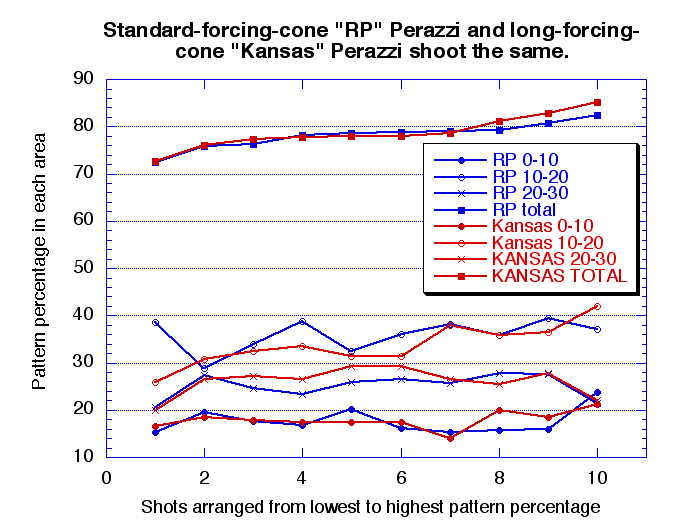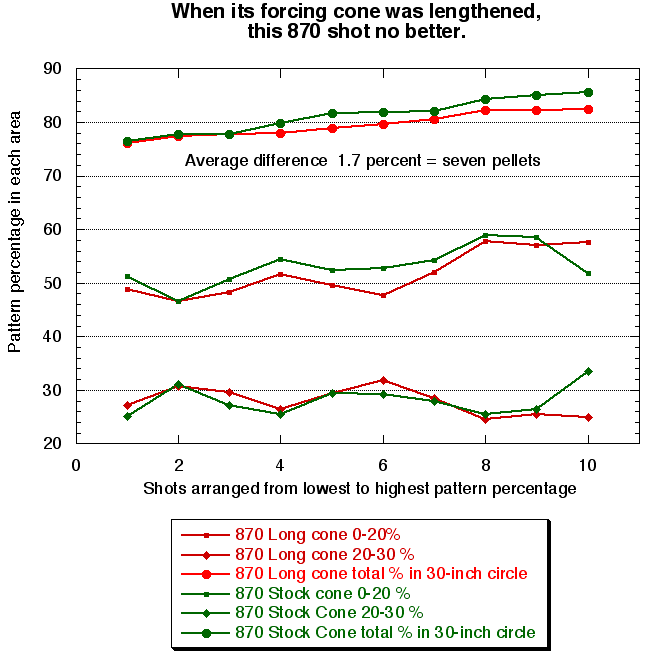


The Mysterious Lengthened and Elongated Forcing Cone

Above, courtesy of Neil Winston and claytargettesting.com, are pattern percentage comparisons between a standard forcing cone Perazzi and a "long cone" Perazzi. In the eternal search for pattern improvement, precision forcing cone machining failed to do much of anything.
One of the most highly touted features of a shotgun today is the mysterious lengthened forcing cone. Lengthened forcing cones have been touted to reduce recoil, give higher velocities, improve patterns and just about everything else you can imagine—perhaps giving us more miles per gallon as well. It falls into the category of what we like to call a "feature."
Features don’t have to do much; in fact they don’t have to really do anything at all. For a feature to be a “feature,” it just has to exist. If it exists, it can be advertised. It helps if we can’t measure the benefit of this feature easily, or at all. That way, no one can say we are wrong.
Shotgun makers like features. If they crow about it long enough and loud enough, then sooner or later they don’t even have to pretend to know what it does, or state what it does. When they advertise it in big, bold letters, people assume it is a very good thing, otherwise they wouldn’t make such a fuss about it.
That brings us to "Lengthened Forcing Cones!" or perhaps the more esoteric, "Precision-crafted, Highly Polished, Elongated Forcing Cone." They are about the same thing, of course, but we can ask a little bit more for our features if they take longer to say, or are harder to pronounce. "Cryogenic Elongated Forcing Cones" likely sell for a bit more.
When was the last time you saw a good shotgun pattern and rushed to measure your forcing cone? After someone shoots a good round of sporting clays, do people gather round and plead in hushed tones, "Could you tell me the length of your forcing cone, please?" What is the preferred forcing cone length of Olympic medalists, anyway? Somehow, that little bit of information never seems to make the news.
A forcing cone, of course, is the transition area from chamber dimension to the bore of your shotgun. The length is not really the point; it is the degree of taper. In theory, a more gentle taper is less disruptive to shot and wad. A short cone might be a bit under a half-inch section with a correspondingly sharp taper, where a long cone might be two or three inches or even longer. The beauty of a lengthened forcing cone is that we don’t have to say what the length was before you lengthened it, or what it is now. This is particularly amusing in the case of brand new models, never before manufactured, with "lengthened" forcing cones. It forces the consumer to believe that they were going to make it with shorter cones, but erased that part from the production prints and then lengthened them. Even though they aren’t any longer or shorter than they ever were, they only come one way, they are now lengthened because they could have made them shorter if they wanted. It is a lot like "room temperature," as no matter how hot or cold a room gets, it is still "room temperature."
Recently, I had a long session with one of top engineers in the industry, whose company has recently introduced a lengthened forcing cone on a couple of new models. After exchanging the usual pleasantries, the subject of forcing cones was breached. "You did some extensive R & D with these models, correct? A large quantity of shooting, carefully documented, with a variety of shells?" After being assured that this was indeed the case, with a great deal of time and money spent, I was told the new forcing cones gave beautiful and better patterns.
Naturally, I asked, "What can you show?" In other words, after all this R & D work, with a clean slate and the ability to use any forcing cone length you please, what is the documented benefit? A more even pattern? A higher percentage pattern? A 5% higher percentage pattern? 2%? 1%?
The answer was, "Well, no. We couldn’t quantify any of that." I was a bit surprised. Nothing? No trend? Something perhaps with steel or other chaotic shot? Nothing with higher velocity loads, or higher payload loads? Nothing, not even an average of three pellets per shot increase in a 30 inch circle at 40 yards? The answer was clear: "No, we couldn’t find anything. The physics are sound, though, and it should work. We can say it doesn’t hurt anything."
That is the crux of this biscuit. There are several approaches that sound good, or can at least be made to sound very good regardless of manufacturer or brand. In terms of tangible, real-world performance there is often nothing that can be reliably shown, or shown at all. In the case of elongated forcing cones, on the list of really important shotgun features of the day, it ranks very close to the search for Bigfoot. While we can’t say that searching for Bigfoot will improve your shotgun patterns, we can confidently say that it doesn’t hurt anything.
My Stan Baker “Moneymaker” barrels consistently did three things for me: lowered muzzle velocity, did nothing to improve patterns, and cost me time and money. The lower muzzle velocity is consistent with basic internal ballistics: burn the same amount of powder in a larger barrel volume, the entire pressure curve drops slightly. Slightly less pressure acting on the wad for the length of the barrel invariably means a velocity loss. No surprise there, a 30 – 50 fps less in muzzle velocity with a back-bored or “overbored” barrel is to be expected, with slightly less recoil as a bonus if you want to call it that.
Don Zutz did a couple of specific case studies in his book, Shotgunning Trends In Transition. The guns modified were a Remington 1100 and a Browning A-5 12 Mag. Pattern percentages before and after went both up and down, with no universal improvement. Two of the worst examples were with the A-5, where the forcing cone work took an 86% pattern with #2 steel factory load and changed it into a 70% pattern, also changing a #8 hard shot factory target load from 71% to 65%.

Above, courtesy of Neil Winston, carefully lengthened and polished forcing cones failed to provide positive results, with the unmodified barrel actually offering slightly greater pattern efficiencies overall.
More recently, Neil Winston conducted his own before and after with a Remington 870 and the results were clear: forcing cone work did nothing to improve the performance. Actually, on average, pattern efficiency actually fell by 1.7 percent. Neil also took the time to compare a “short cone” Perazzi with a “long cone” Perazzi, the result being they shot the same. More info from and about Neil is found on his site: http://www.claytargettesting.com .
Eldon Canady performed a series of before and after tests with forcing cone work only performed on an Ithaca M37. There was substantial velocity loss with both Federal target ammo and Remington target ammo: the Federal loads lost 36 fps while the Remington loads lost an average of 58 fps. Mr. Canady's testing was particularly good as he used an unmodified baseline control barrel to guarantee the fidelity of the testing. Further, rather than an error-prone three of four shots, Mr. Canady used 12 shot averages throughout the testing. What about back-boring? In Tom Roster's Shotgun Barrel Alteration Manual Tom documented the velocity loss from back-boring as “35 – 125 fps.”
Back-boring
and forcing cone work guarantees lower muzzle velocities due to increased
barrel volume. It is just a question of how much which will vary indefinitely
by individual gun and specific shell. Forcing cone work does nothing quantifiable
to improve patterns. In the case of the Don Zutz and Neil Winston case
studies, it either does essentially nothing appreciable (Winston) or might
hurt things as well as help (Zutz) as far as pattern efficiencies. The
comments about “less felt recoil” from lengthened forcing cones
are naturally understandable, as you have likely just turned your “3
dram equivalent” loads into “2-3/4 dram equivalent loads"
or thereabouts.
Copyright 2011 by Randy Wakeman. All Rights Reserved.





